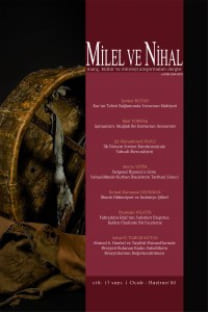Titus Burckhardt ve Mimaride Dini Sembolizm
Titus Burckhardt, Gelenekselcilik, İslam mimarisi, sembolizm, anikonizm
Titus Burckhardt and Religious Symbolism in Architecture
Titus Burckhardt, Traditionalist, Islamic architecture, symbolism, aniconism,
___
- Heather Elgood, Hinduism and the Religious Arts, New York 2000.
- İsmail Taşpınar, Doğu Dinlerinde Hac İbadeti, Hinduizm ve Budizm, İstanbul, 2016.
- Kitabı Mukaddes Eski ve Yeni Ahit, İstanbul 1996.
- Malek Chebel, Dictionnaire des Symboles Musulmans, Rites, Mystique et Civilisation, Paris 1995.
- Müttefekun Aleyh Hadisler, Buharî ve Müslim’in İttifak Ettikleri Hadisler, Haz.: Abdullah Feyzi Kocaer, İstanbul 2005.
- Selçuk Mülayim, Türk Sanatında İkonografik Dönüşümler, Değişimin Tanıkları, İstanbul 2015.
- Selçuk Mülayim, İslâm Sanatı, Ankara 2013.
- Titus Burckhardt, L’Art de l’Islam, Langage et Signification, Paris 1985.
- ISSN: 1304-5482
- Yayın Aralığı: Yılda 2 Sayı
- Başlangıç: 2003
- Yayıncı: Milel ve Nihal: Eğitim, Kültür ve Düşünce Platformu Derneği
Muallak Taşı’nın Kutsal Mimarisi: Mescid-i Aksa’da Yenilikçi Tasarım Konsepti ve İkonografi
Titus Burckhardt, Doğu’da ve Batı’da Kutsal Sanat: Sanatın İlkeleri Ve Yöntemleri
‘Kutsal Mekan’: Fenomenolojik Bir Analiz
Ümit Horozcu, Kutsal Açlık Yeme Riyazeti ve Anoreksiya Nervoza
Titus Burckhardt ve Mimaride Dini Sembolizm
Kutsalı Konumlamak: Haram Bölgesi-Mekke
Kur’an’ı Anlamada Usûl Üzerine
